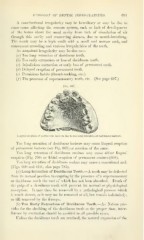Page 693 - My FlipBook
P. 693
—
ETIOLOGY OF DENTAL IRREGULARITIES. 691
A constitutional irregularity may be hereditary or may be due to
some cause affecting the osseous system, such as lack of development
of the bones about the nasal cavity from lack of circulation of air
through this cavity and connecting sinuses, due to mouth-breathing.
The result may be a high vault with a small and narrow arch, and
consequent crowding and various irregularities of the teeth.
An acquired irregularity may be due to
(a) Too long retention of deciduous teeth.
(6) Too early extraction or loss of deciduous teeth.
(c) Injudicious extraction or early loss of permanent teeth.
(d) Delayed eruption of permanent teeth.
(e) Pernicious habits (thumb-sucking, etc.).
(/) The presence of supernumerary teeth, etc. (See page 697.)
Lingual eruption of permanent incisors due to too long retention of deciduous incisors.
Too long retention of deciduous incisors may cause lingual eruption
of permanent incisors (see Fig. 607) or rotation of the same.
Too long retention of deciduous canines may cause either lingual
eruption (Fig. 700) or labial eruption of permanent canines (608).
Too long retention of deciduous molars may cause a constricted arch
(Figs. 609 and 610; also page 785).
(«) Long Retention of Deciduous Teeth.—A tooth may be deflected
from its normal position in erupting by the presence of a supernumerary
or deciduous tooth the root of which has not been absorbed. Death of
the l)ulp t>f a deciduous tooth will prevent its normal or physiological
resorption. It may then be removed by a pathological process Mhich
is much slower, or it may not be removed at all, but remain indefinitely,
or till removed by the forceps.
(6) Too Early Extraction of Deciduous Teeth,—As Nature pro-
vides for the shedding of the deciduous teeth at the proper time, inter-
ference by extraction should be avoided in all possible cases.
Unless the deciduous teeth are retained, the natural expansion of the
ETIOLOGY OF DENTAL IRREGULARITIES. 691
A constitutional irregularity may be hereditary or may be due to
some cause affecting the osseous system, such as lack of development
of the bones about the nasal cavity from lack of circulation of air
through this cavity and connecting sinuses, due to mouth-breathing.
The result may be a high vault with a small and narrow arch, and
consequent crowding and various irregularities of the teeth.
An acquired irregularity may be due to
(a) Too long retention of deciduous teeth.
(6) Too early extraction or loss of deciduous teeth.
(c) Injudicious extraction or early loss of permanent teeth.
(d) Delayed eruption of permanent teeth.
(e) Pernicious habits (thumb-sucking, etc.).
(/) The presence of supernumerary teeth, etc. (See page 697.)
Lingual eruption of permanent incisors due to too long retention of deciduous incisors.
Too long retention of deciduous incisors may cause lingual eruption
of permanent incisors (see Fig. 607) or rotation of the same.
Too long retention of deciduous canines may cause either lingual
eruption (Fig. 700) or labial eruption of permanent canines (608).
Too long retention of deciduous molars may cause a constricted arch
(Figs. 609 and 610; also page 785).
(«) Long Retention of Deciduous Teeth.—A tooth may be deflected
from its normal position in erupting by the presence of a supernumerary
or deciduous tooth the root of which has not been absorbed. Death of
the l)ulp t>f a deciduous tooth will prevent its normal or physiological
resorption. It may then be removed by a pathological process Mhich
is much slower, or it may not be removed at all, but remain indefinitely,
or till removed by the forceps.
(6) Too Early Extraction of Deciduous Teeth,—As Nature pro-
vides for the shedding of the deciduous teeth at the proper time, inter-
ference by extraction should be avoided in all possible cases.
Unless the deciduous teeth are retained, the natural expansion of the


